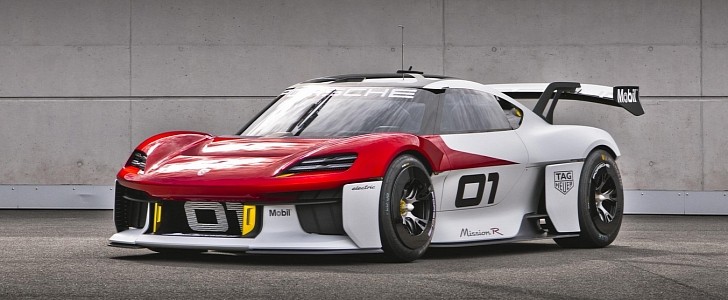True to its motorsport tradition, Porsche decided to present an all-electric concept car at the IAA 2021. The Mission R aims to tackle tracks around the world with multiple attractive solutions to keep running for as long as possible. However, the 800-kW (1,073-hp) beast did not take charging off the table: it just reduced the time to do that.
According to Porsche, the Mission R can replenish 80% of its 80 kWh battery pack in only 15 minutes thanks to a 900V system, a 340 kW charging speed, and direct oil cooling. According to Porsche, this new method to control the temperature at the cell level would prevent derating for good. This process consists of reducing the battery pack output to prevent it from getting too hot.
If it delivers what it is promising, we should see this direct oil cooling in many future Porsche EVs. Despite that, 15 minutes in a race are quite a while to wait. Would Porsche ever consider battery swapping to create an electric race car? It seems to be the only feasible solution for some of the most traditional race formats today, such as the 24 Hours of Le Mans or the Indy 500. Either Porsche will propose races that last as long as the battery pack can deliver electrons, or the charging time will be part of the show – somehow.
The Mission R has two electric motors. The one in the front axle delivers 320 kW (429 hp), and the one for the rear can generate up to 480 kW (644 hp). Although that’s quite some power, the performance numbers for this vehicle are not that impressive compared to those of the Tesla Model S Plaid, for example.
While the American liftback reaches 60 mph in a little more than 2 seconds, the Mission R takes less than 2.5 s to get to 100 km/h (62 mph). Both vehicles may have very similar times, but the way Porsche disclosed the Mission R’s numbers did not make it look exceptionally competitive. Tesla claims the Plaid reaches 200 mph (322 km/h) of top speed. Porsche only said the Mission R goes beyond 300 km/h.
The technical specifications do not make it any easier for the Mission R. It must have a lightweight body due to the use of NFRP (natural fiber reinforced plastic). The natural fiber in question is flax. The Porsche is also much smaller: it is 4.33 meters (170.5 inches) long, 1.99 m (78.4 in) wide, and 1.19 m (46.9 in) tall. It is shorter, wider, and lower than a Porsche 718 Cayman.
Despite these handicaps, the technologies announced for the Mission R may help Porsche build better EVs. The Taycan is already praised as one of the finest EVs for sale. The improvements the Mission R may introduce are likely to improve it and other electric Porsches by a wide margin.
If it delivers what it is promising, we should see this direct oil cooling in many future Porsche EVs. Despite that, 15 minutes in a race are quite a while to wait. Would Porsche ever consider battery swapping to create an electric race car? It seems to be the only feasible solution for some of the most traditional race formats today, such as the 24 Hours of Le Mans or the Indy 500. Either Porsche will propose races that last as long as the battery pack can deliver electrons, or the charging time will be part of the show – somehow.
The Mission R has two electric motors. The one in the front axle delivers 320 kW (429 hp), and the one for the rear can generate up to 480 kW (644 hp). Although that’s quite some power, the performance numbers for this vehicle are not that impressive compared to those of the Tesla Model S Plaid, for example.
While the American liftback reaches 60 mph in a little more than 2 seconds, the Mission R takes less than 2.5 s to get to 100 km/h (62 mph). Both vehicles may have very similar times, but the way Porsche disclosed the Mission R’s numbers did not make it look exceptionally competitive. Tesla claims the Plaid reaches 200 mph (322 km/h) of top speed. Porsche only said the Mission R goes beyond 300 km/h.
The technical specifications do not make it any easier for the Mission R. It must have a lightweight body due to the use of NFRP (natural fiber reinforced plastic). The natural fiber in question is flax. The Porsche is also much smaller: it is 4.33 meters (170.5 inches) long, 1.99 m (78.4 in) wide, and 1.19 m (46.9 in) tall. It is shorter, wider, and lower than a Porsche 718 Cayman.
Despite these handicaps, the technologies announced for the Mission R may help Porsche build better EVs. The Taycan is already praised as one of the finest EVs for sale. The improvements the Mission R may introduce are likely to improve it and other electric Porsches by a wide margin.























